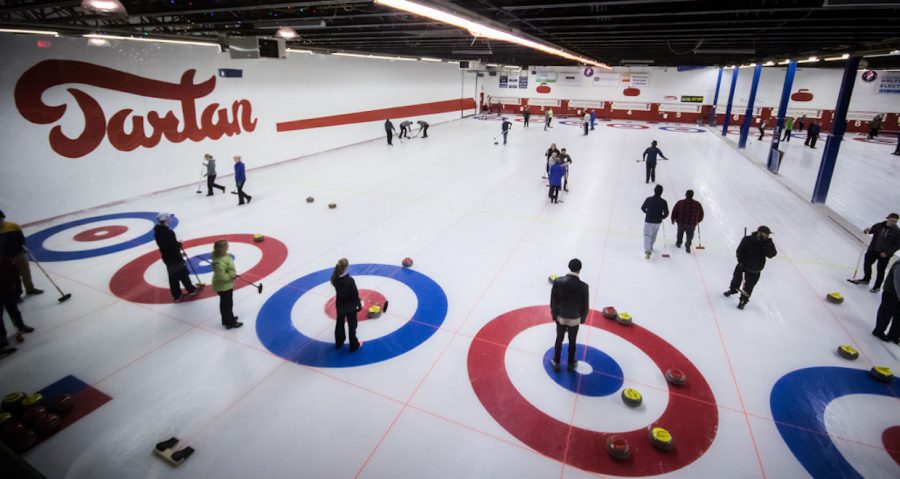Like a (sliding) stone: the appeal of an unusual Winter Olympic event
February 16, 2018
Turn on your television this month and you may be greeted by images of a sport where participants slide large stones on a sheet of ice towards a target, closely leading the stone towards its target by sweeping the ice with brooms. This seemingly absurd sport is known around the world by the name of curling, and has left viewers of the 2018 Winter Olympics enthralled and eager to play the game that is often called “Chess on Ice” for the vast amount of strategy required to achieve victory.
The 2018 Winter Olympics are currently underway in Pyeongchang, South Korea. The Winter Olympics, occurring every four years, are the premier showcase for winter sports in the world. And while some winter sports such as figure skating and hockey have gained public recognition and and are commonly played, the aforementioned sport of curling is most certainly not on the list of most popular sports in the United States. Because of the nature of the sport, curling has gained a cult following on social media sites such as Twitter and Instagram, with many users making curling-related jokes and memes.
But make no mistake, curling is not a joke, and though it may resemble the shuffleboard game that is frequently played by older players, curling is a sport that requires both physical and mental skill to compete at a high level.
If this years’ Winter Olympics has been your introduction to the sport, you probably have more questions than answers.
“I still don’t think I understand the intricacies of the game or why exactly the players carry brooms and shout loudly, but I’m definitely curious. I think I have the natural skill to be a good curler,” senior Carlos Aleman said.
For the sake of brevity, I won’t go too in depth in explaining the rules of curling, but the game is relatively simple to understand.
Curling is a game with two teams each consisting of four players going head-to-head. One player slides a large, 16-pound puck-like object, called a “stone,” on ice towards a circular target at the end of the ice, while other players use brooms to sweep the area in front of the stone as it slides in an effort to reduce friction and influence its path. The objective of the sport is to get the stone directly in the middle of the circular target, called the “house.” Each team takes turns with sliding stones, adding an element of strategy and competition considering that the teams attempt to knock the opposing teams stone out of the house. Each team must slide eight stones, with each of the four players sliding two. When each team has thrown their eight stones, this constitutes an “end,” similar to an inning in baseball. The team with the most amount of stones closest to the house wins the end, and the team that wins the greater number of ends is victorious. A full game of of Olympic curling consists of 10 ends.
Curling was invented in Scotland in the 16th century, and since then has continued to evolve and exist as a sport to this very day. Curling is most firmly established in places like Canada and Scandinavian countries, where winter conditions are ideal for playing outdoor curling on frozen ponds or lakes. Canada has dominated the Winter Olympic events, and it is considered a winter past-time there.
Though our northern neighbors have adopted curling as a serious sport, the United States has not been so quick to catch on. There are not nearly as many curling centers in the United States as in Canada, and very few ice rinks offer curling leagues, despite a much higher population. However, every four years the nation watches the Winter Olympics, and for a fleeting moment curling gets the public recognition it does not normally enjoy.
The appeal of curling for a casual viewer is obvious. The game can certainly appear humorous at times with its vigorous sweeping and loud call-outs of directions for the sweeper to follow. Seemingly every four years, there is a new-found interest in the sport, and in both 2010 and 2014, previous Olympic years, curling became a trending topic on twitter. Not all of this attention is positive, with some slating the game and deriding it as “not a real sport.” For the more open-minded, curling is a captivating event with unusual rules and regulations, and many are eager to try it out.
Chicago is a large, metropolitan city, and with this large size comes some perks. You can find places to practice nearly any hobby in Chicago, and curling is no exception.
“After the 2014 Winter Olympics in Sochi, my family was obsessed with curling and my mom really wanted to try it out. It turns out there’s a place called the Windy City Curling Club in Woodridge, so my family went on an outing. I had a great time curling and it’s funny to tell people about, especially during Olympic years,” Philip Krause, sophomore, said.
Windy City Curling Club is one of a variety of options for those who desire to curl in Chicago, and is recommended here for the ability of minors to participate. A large amount of curling centers have age-requirements of 21 years old, but Windy City Curling Club does not.
Curling is an excellent microcosm of the Winter Olympics as a whole. In comparison to the Summer Olympics, the Winter Olympics are largely unconventional, with events such as curling, skeleton, and cross-country skiing being regional sports that are not popular in the United States. Despite the oddity of these events, for the Olympic participants they are the pinnacle of their sporting lives, something that they have undoubtedly sacrificed for. The Winter Olympic games allow us to view and experience culture that we do not normally see, a perspective we should not take for granted.








